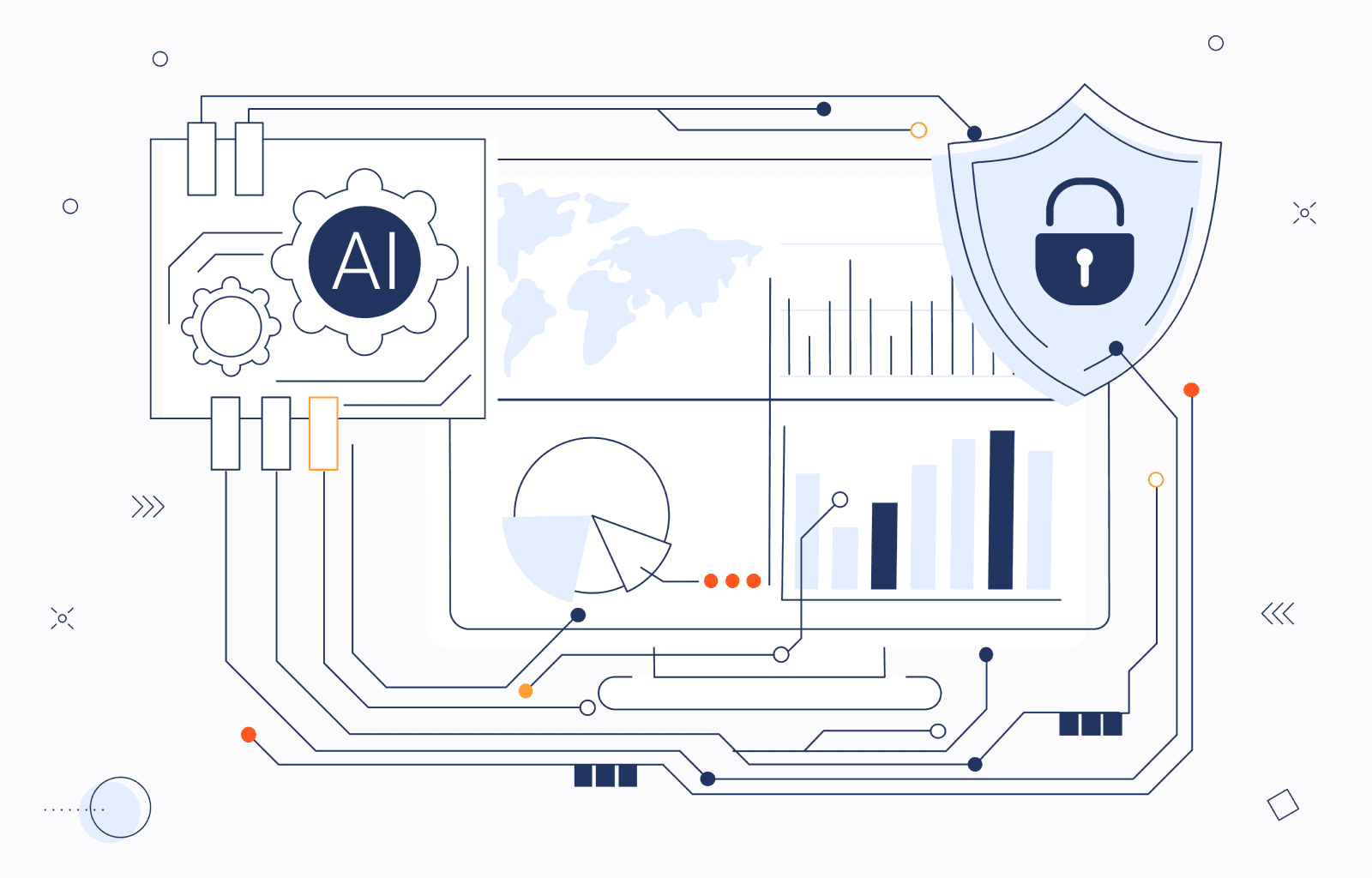ERP and Data Security: Ensuring Compliance with Canadian Regulations

The number of cybersecurity breaches increased by 72 percentage points between 2021 and 2023. Over 350 million people became victims of 3,200+ compromises. At the same time, the number of organizations impacted increased by 2,600 percentage points since 2018. The global average recovery cost for businesses in 2023 was $4.45 million, 15% higher than in 2020.
Data security in ERP systems has become critical since they hold sensitive financial and personal information from multiple departments. ERP breaches can result in ransomware attacks, data exposures, and leaks. Aside from operational disruptions, they lead to legal risks, including noncompliance penalties, reaching from 100,000 CAD to 10 million CAD for Canada.
In this post, we’ll review the biggest ERP security risks and how they align with Canada’s data security regulations. We’ll also share IT expertise on mitigating said risks through safety strategies.
Data Security in ERP Systems
Enterprise resource planning (ERP) systems integrate financial, sales, manufacturing, supply chain, human resources, and other components. This facilitates daily operations. However, it also makes ERP systems targets for cyber attacks. Upholding ERP data security helps businesses maintain:
Regulatory compliance. Under Canadian law, private businesses, including small and medium enterprises, are bound by federal and provincial Acts, including PIPEDA, Alberta PIPA, BC PIPA, Quebec Act, CASL, and others. Failure to comply may lead to fines.
Financial security. ERP systems store internal financial information and customer data. Losing either may result in direct financial losses, identity theft, credit card fraud, and other risks.
Talent shortages. Although the number of unfilled positions has been going down since its peak in 2022, talent shortages are from over. That’s why manufacturers continue to experience disruptions due to competing for talent – and cite lack of available talent as a key challenge.
Operational stability. Security breaches may result from DDoS attacks, malware, or unauthorized access. Any of these external disruptions in ERP systems related to daily processes or supply chains prevent normal operations.
Customer perception. Customers do not take kindly to businesses losing their data. Nor do they appreciate delayed service or lost products. When combined with the knowledge of noncompliance with Canadian data security regulations, these issues will encourage customers to seek your competition and make attracting new clients tougher.
While the severity of financial security, operational stability, and reputation repercussions may differ, Canadian data security regulations explicitly specify penalties for noncompliance.
Canadian Data Security Regulations
The Privacy Act is Canada's prime data security regulation. It applies to personal information handled by the federal government and establishes Canada`s Privacy Commissioner position.
Private for-profit organizations fall under the PIPEDA (Personal Information Protection and Electronic Documents Act) of 2000. The Act applies across Canada, except provinces with local data protection regulations:
Alberta — Personal Information Protection Act (Alberta PIPA)
British Columbia — Personal Information Protection Act (BC PIPA)
Quebec — Act respecting the protection of personal information in the private sector (Quebec Act)
Under the current law, businesses must inform consumers if their data is compromised. If you don’t notify affected people, your business can be fined 50,000 CAD to 100,000 CAD.
Canada’s Anti-Spam Legislation (CASL) protects businesses and customers from electronic threats. The law prohibits the installation of computer programs without the computer owner’s explicit consent and outlaws changing email data to deliver it to another destination (or additional destinations). The maximum penalty under CASL is 10 million CAD.
At the same time, the government is working on the new Consumer Privacy Protection Act (CPPA) within the bounds of the Digital Charter Implementation Act. The new Act would involve meaningful consent, data mobility, and the right to disposal. It would also require transparency in using AI to make decisions and predictions about Canadian citizens. Fines would reach 5% of revenue or 25 million CAD, and administrative monetary penalties—3% of revenue of 10 million CAD.
Another upcoming change deals with the use of artificial intelligence. Artificial Intelligence and Data Act (AIDA) will regulate the design, development, and use of AI systems. It will also include restrictions for using data that may harm Canadians.
Although CPPA and AIDA have yet to be enacted, businesses should proactively prepare for legislative changes. Timely adjustments can protect them from the legal and financial repercussions of noncompliance.
5 Strategies for Ensuring Data Security in Your ERP System
Dozens of small things affect data security, from weak passwords to offboarding failures. But we’ll focus on five strategic moves that address the biggest risks and profoundly impact ERP security. Implement them to protect your sensitive data and comply with Canadian data security regulations.
Regular Security Audits
Surveys show that 64% of enterprises suffer ERP breaches despite user audits held every 90 days. As ERP systems become more advanced, vulnerabilities multiply. Most companies rely on legacy software with multiple patches and modules cobbled together to integrate operational functions. Constant security updates are a must to address emerging threats.
At the same time, regular security audits must become a part of the quarterly routine after the initial security assessment. Once you understand the weakest points in your digital infrastructure, you can develop a plan for addressing each issue. For instance, if employees use weak passwords, you can implement a validation protocol to ensure each password includes a minimum of eight characters of different registers, digits, special characters, etc.
ERP security assessment should become a continuous process. Once security audits become routine, store the findings and recommendations for future analysis. This will help evaluate the effectiveness of the implemented measures and encourage you to try alternative solutions if initial recommendations do not result in expected data security improvements.
Robust Access Control Measures
The issue is twofold.
On the one hand, indiscriminately giving ERP access to all employees is a recipe for disaster. And so is failing to rescind access once employees leave the company. Automated and secure authorization workflow can resolve the issue. Considering the ERP systems’ complexity, using multiple access tiers is critical. Employees should only have access to individual modules to fulfill their duties. At the same time, sharing and blocking access should be easy for higher-level employees if another level of access or integration becomes necessary.
On the other hand, one-factor authentication is not enough to protect sensitive ERP systems from breaches. Yet, according to different surveys, 5% to 40% of businesses still use it. Small businesses are especially reluctant to implement multi-factor authentication. As a result, cyber attackers may resort to phishing or brute-force attacks to uncover employee passwords and access private data.
Two-factor authentication (2FA) provides an added layer of security despite its added costs and implementation complexity. It can be especially challenging for businesses using a large number of IoT devices, which can serve as entry points for attackers if left unprotected by 2FA. User friction is another common adoption barrier for 2FA, but training and awareness programs should help combat it.
Data Encryption and Secure Storage Solutions
Encryption makes data unreadable to anyone without decryption keys. So, even if the breach is successful, criminals cannot use sensitive information. Moreover, encryption is often a regulatory requirement for data security in ERP systems.
If you don’t have the required expertise in-house, you can outsource data encryption solutions. But you’ll also need to account for increased performance overhead, as processing time will likely increase and cause additional operational friction. Besides, encryption is only as safe as the decryption keys are. They should remain safe to keep the data accessible while staying out of the wrong hands.
Data processing, storage, and export should also be secure. Cloud solutions can help preserve sensitive information, but they may raise the cost of ERP system maintenance. At the same time, action logs and notifications should be part of a real-time monitoring system. If any user gives an unauthorized command, IT personnel should receive relevant notifications and prevent such actions. Alternatively, you can automate security measures. For that, you will need a team dedicated to updating protocols as new modules and databases are added to the ERP system.
Employee Training and Awareness Programs
94% of organizations reported email security incidents in 2023. It’s unsurprising, considering that 35% of all malware attacks result from emails. Phishing incites 74% of account takeover attacks; even IT giants like Microsoft, Google, and Apple aren’t safe from them. All this is to say that people are the weakest link in any security system. Therefore, there can never be too much training.
Sending out a company-wide memo is not the same as running an awareness program. For one, your employees must understand why security measures are not frivolous but integral to their long-term employment. Educate them on the risks of noncompliance, data breaches, and ransomware attacks for your company and each employee. Hiring an expert team to develop security measures and run practice breach attempts is a good idea, especially if you make it a part of your security audit routine.
If possible, automate security measures to mitigate the human factor. For instance, assign complex passwords for each account instead of hoping employees will comply with security best practices. You can also prohibit data export and block USB data access points.
Advanced Security Solutions
With a cybersecurity workforce gap of over 4 million, cybersecurity remains a concern for most businesses. However, advanced solutions can make up for the missing data security employees. Just as AI personalization can boost business outcomes, machine learning can be equally effective in data security. It can be implemented alongside any of the four practices above:
AI algorithms can analyze the results of security audits, provide actionable insights, and facilitate decision-making. Reporting can also be automated.
Machine learning can simplify access management by analyzing changing access requirements and suggesting adjustments as employees’ duties change.
Smart algorithms can keep an eye on the real-time access and activity log, notice irregularities, send out notifications, and prevent security breaches.
AI can also develop data security training protocols, log employees’ performance, and create personalized awareness materials and instructions.
You can use ready-made solutions, but if you rely on legacy software, you’ll have better luck getting a local IT team to develop an AI-powered ERP data security solution. Tailored to your needs, it will be more effective.
Conclusion
ERP data security affects the bottom line as much as your business’ reputation. Data breaches are bad enough for business, but they can also put you in violation of PIPEDA and other Canadian data security regulations. But you can avoid trouble by implementing the five strategic moves we share. Start with a security audit and a training program for employees, and implement encryption and access management best practices. If you need help with any of these or wish to implement advanced security solutions, contact our team for a consultation.
Contact us

